The Impact of Hierarchy and Power on Healthcare in Australia
VerifiedAdded on 2023/06/06
|10
|2928
|396
Essay
AI Summary
This essay delves into the intricate dynamics of hierarchy and power within the Australian healthcare system, examining their influence on healthcare delivery and accessibility. It explores various sociological perspectives, including functionalism, conflict theory, and symbolic interactionism, to understand how these power structures affect the quality of care, particularly for vulnerable populations. The essay also considers the historical, cultural, and structural aspects of the Australian healthcare system, highlighting the roles of medical professionals, technology, and government policies. Furthermore, it addresses the implications of these power dynamics for health practitioners and the importance of addressing social determinants of health to ensure equitable healthcare access for all Australians. The essay concludes by emphasizing the need for policy changes and healthcare reforms to promote a more just and inclusive healthcare system.
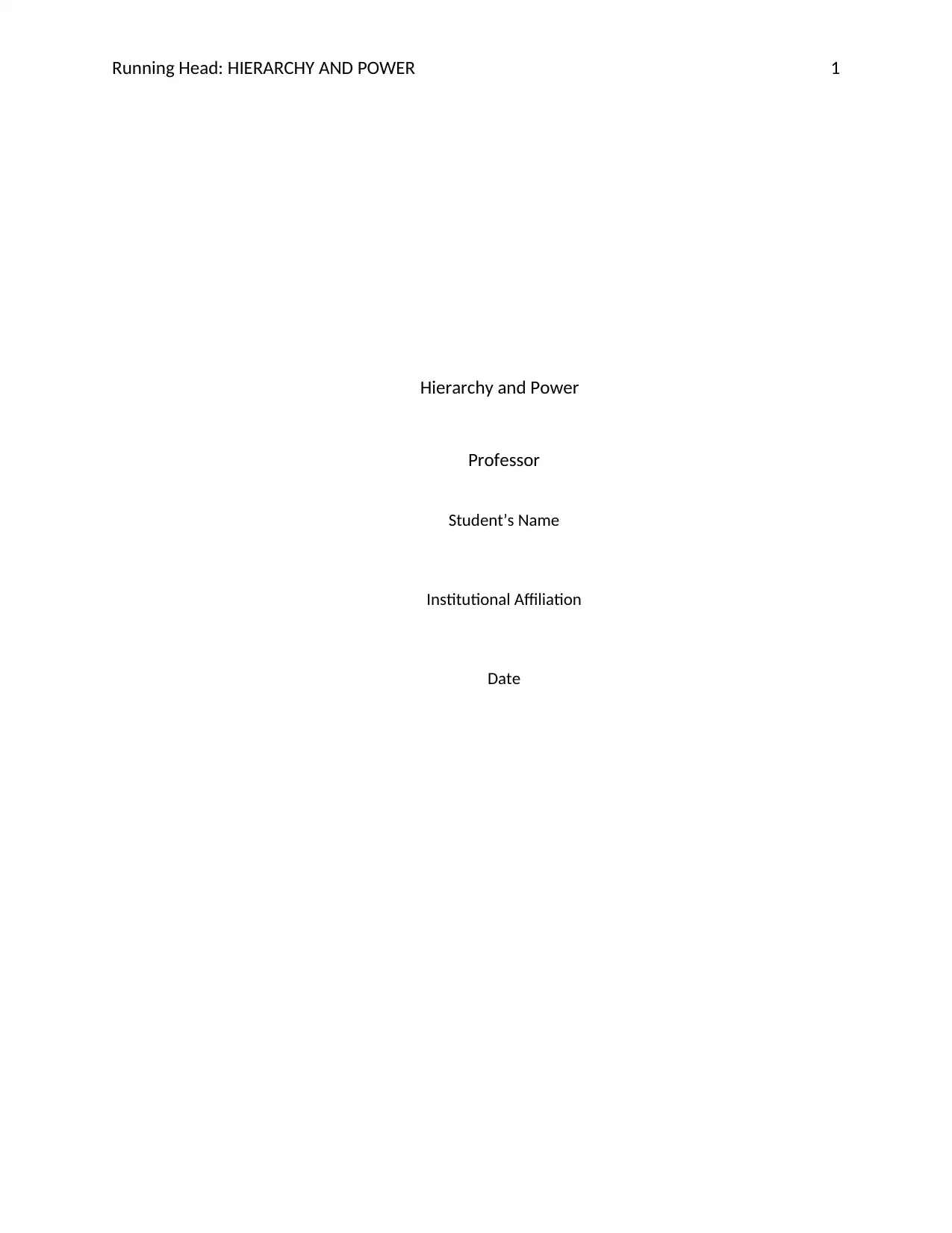
Running Head: HIERARCHY AND POWER 1
Hierarchy and Power
Professor
Student’s Name
Institutional Affiliation
Date
Hierarchy and Power
Professor
Student’s Name
Institutional Affiliation
Date
Paraphrase This Document
Need a fresh take? Get an instant paraphrase of this document with our AI Paraphraser

HIERARCHY AND POWER 2
Hierarchy and power are intrinsic to the current health care system in Australia
Introduction
Health is essential for everyone in Australia. The current care systems in Australia
provides a word scope of services from population health to general practice, emergency health
services, and hospital care. Hierarchy and power are necessary when it comes to the current
healthcare systems. The citizens of Australia particularly the poor and the low-income earners
need to be given best health care services. There are sociological perspectives that go hand in
hand with the healthcare systems. People from different ethnicities and races who need to be
treated with care (Mossialos et al., 2016).Cultural beliefs and practices may differ strictly from
those rooted in the Anglo-Australian community. In some cities, ill health is believed to be
caused by evil spirits. There are people with different cultures in Australia.
Theoretical Perspectives
Health is defined as the extent of an individual's mental, physical and social well-being
while health care systems deal with the provision of health services. There are specific
sociological explanations about health care systems. They give a more understandable
approach concerning health. The first theoretical perspective is functionalism. The assumption
is that for the smooth functioning of the community, adequate medical care and good health is
essential. The sufferers have to execute the ‘sick role' for them to be seen as legitimately sick
and to release them from their normal responsibilities.
The medic-sufferer relationship is hierarchical where the medic gives instructions, and
the patient is required to follow them (Sociological Perspectives Reviewers, 2013). In
functionalists’ perspective, Sickness discourages the ability to perform their responsibilities in
the community, and if many individuals are unhealthy, the stability and functioning of the
community will be affected. It prevents people from carrying out their social responsibilities,
therefore, presenting an inadequate result to the community. Inadequate health care services
affect the society as people from poor background are likely to get sick and become unhealthy
due to various reasons
Hierarchy and power are intrinsic to the current health care system in Australia
Introduction
Health is essential for everyone in Australia. The current care systems in Australia
provides a word scope of services from population health to general practice, emergency health
services, and hospital care. Hierarchy and power are necessary when it comes to the current
healthcare systems. The citizens of Australia particularly the poor and the low-income earners
need to be given best health care services. There are sociological perspectives that go hand in
hand with the healthcare systems. People from different ethnicities and races who need to be
treated with care (Mossialos et al., 2016).Cultural beliefs and practices may differ strictly from
those rooted in the Anglo-Australian community. In some cities, ill health is believed to be
caused by evil spirits. There are people with different cultures in Australia.
Theoretical Perspectives
Health is defined as the extent of an individual's mental, physical and social well-being
while health care systems deal with the provision of health services. There are specific
sociological explanations about health care systems. They give a more understandable
approach concerning health. The first theoretical perspective is functionalism. The assumption
is that for the smooth functioning of the community, adequate medical care and good health is
essential. The sufferers have to execute the ‘sick role' for them to be seen as legitimately sick
and to release them from their normal responsibilities.
The medic-sufferer relationship is hierarchical where the medic gives instructions, and
the patient is required to follow them (Sociological Perspectives Reviewers, 2013). In
functionalists’ perspective, Sickness discourages the ability to perform their responsibilities in
the community, and if many individuals are unhealthy, the stability and functioning of the
community will be affected. It prevents people from carrying out their social responsibilities,
therefore, presenting an inadequate result to the community. Inadequate health care services
affect the society as people from poor background are likely to get sick and become unhealthy
due to various reasons
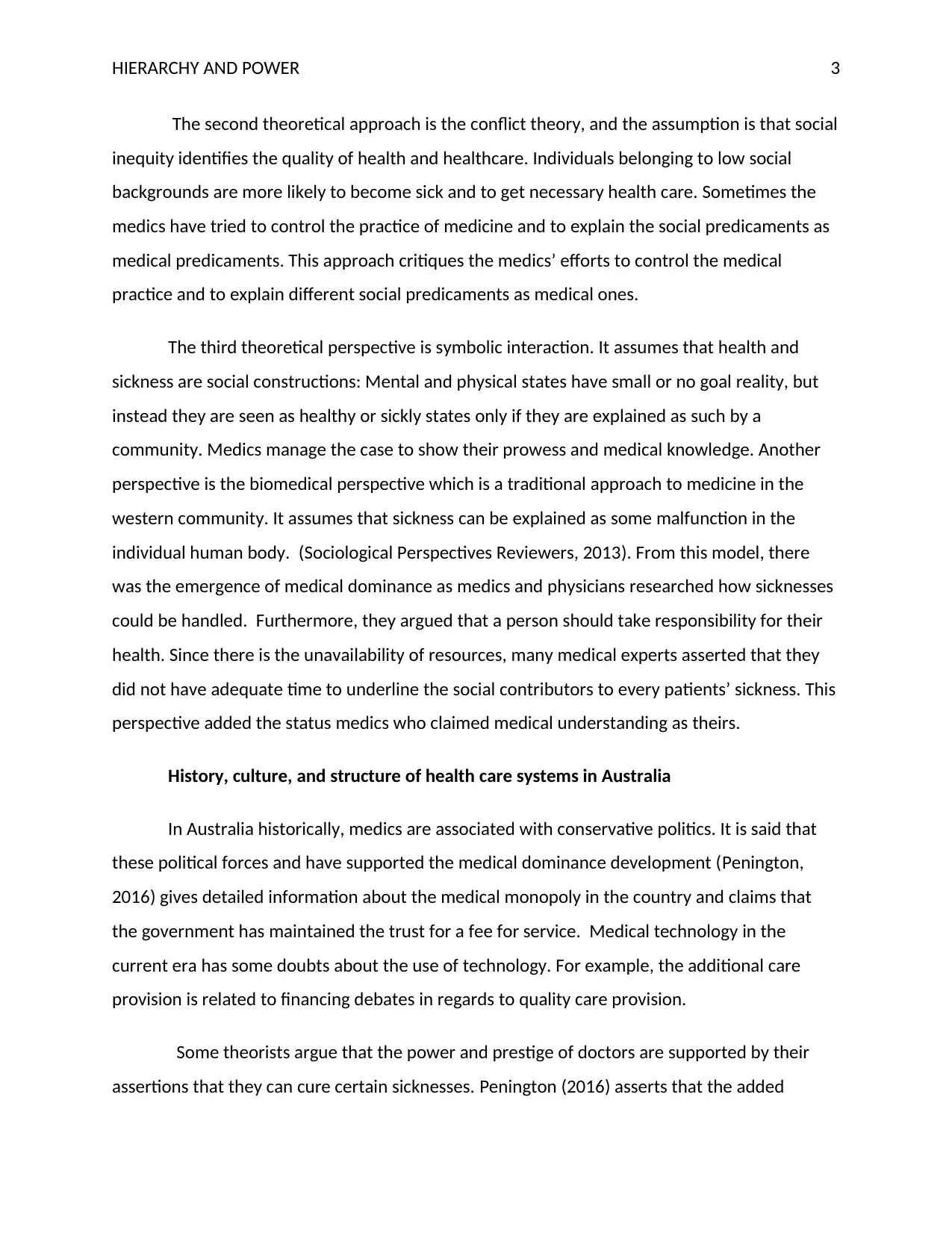
HIERARCHY AND POWER 3
The second theoretical approach is the conflict theory, and the assumption is that social
inequity identifies the quality of health and healthcare. Individuals belonging to low social
backgrounds are more likely to become sick and to get necessary health care. Sometimes the
medics have tried to control the practice of medicine and to explain the social predicaments as
medical predicaments. This approach critiques the medics’ efforts to control the medical
practice and to explain different social predicaments as medical ones.
The third theoretical perspective is symbolic interaction. It assumes that health and
sickness are social constructions: Mental and physical states have small or no goal reality, but
instead they are seen as healthy or sickly states only if they are explained as such by a
community. Medics manage the case to show their prowess and medical knowledge. Another
perspective is the biomedical perspective which is a traditional approach to medicine in the
western community. It assumes that sickness can be explained as some malfunction in the
individual human body. (Sociological Perspectives Reviewers, 2013). From this model, there
was the emergence of medical dominance as medics and physicians researched how sicknesses
could be handled. Furthermore, they argued that a person should take responsibility for their
health. Since there is the unavailability of resources, many medical experts asserted that they
did not have adequate time to underline the social contributors to every patients’ sickness. This
perspective added the status medics who claimed medical understanding as theirs.
History, culture, and structure of health care systems in Australia
In Australia historically, medics are associated with conservative politics. It is said that
these political forces and have supported the medical dominance development (Penington,
2016) gives detailed information about the medical monopoly in the country and claims that
the government has maintained the trust for a fee for service. Medical technology in the
current era has some doubts about the use of technology. For example, the additional care
provision is related to financing debates in regards to quality care provision.
Some theorists argue that the power and prestige of doctors are supported by their
assertions that they can cure certain sicknesses. Penington (2016) asserts that the added
The second theoretical approach is the conflict theory, and the assumption is that social
inequity identifies the quality of health and healthcare. Individuals belonging to low social
backgrounds are more likely to become sick and to get necessary health care. Sometimes the
medics have tried to control the practice of medicine and to explain the social predicaments as
medical predicaments. This approach critiques the medics’ efforts to control the medical
practice and to explain different social predicaments as medical ones.
The third theoretical perspective is symbolic interaction. It assumes that health and
sickness are social constructions: Mental and physical states have small or no goal reality, but
instead they are seen as healthy or sickly states only if they are explained as such by a
community. Medics manage the case to show their prowess and medical knowledge. Another
perspective is the biomedical perspective which is a traditional approach to medicine in the
western community. It assumes that sickness can be explained as some malfunction in the
individual human body. (Sociological Perspectives Reviewers, 2013). From this model, there
was the emergence of medical dominance as medics and physicians researched how sicknesses
could be handled. Furthermore, they argued that a person should take responsibility for their
health. Since there is the unavailability of resources, many medical experts asserted that they
did not have adequate time to underline the social contributors to every patients’ sickness. This
perspective added the status medics who claimed medical understanding as theirs.
History, culture, and structure of health care systems in Australia
In Australia historically, medics are associated with conservative politics. It is said that
these political forces and have supported the medical dominance development (Penington,
2016) gives detailed information about the medical monopoly in the country and claims that
the government has maintained the trust for a fee for service. Medical technology in the
current era has some doubts about the use of technology. For example, the additional care
provision is related to financing debates in regards to quality care provision.
Some theorists argue that the power and prestige of doctors are supported by their
assertions that they can cure certain sicknesses. Penington (2016) asserts that the added
⊘ This is a preview!⊘
Do you want full access?
Subscribe today to unlock all pages.

Trusted by 1+ million students worldwide
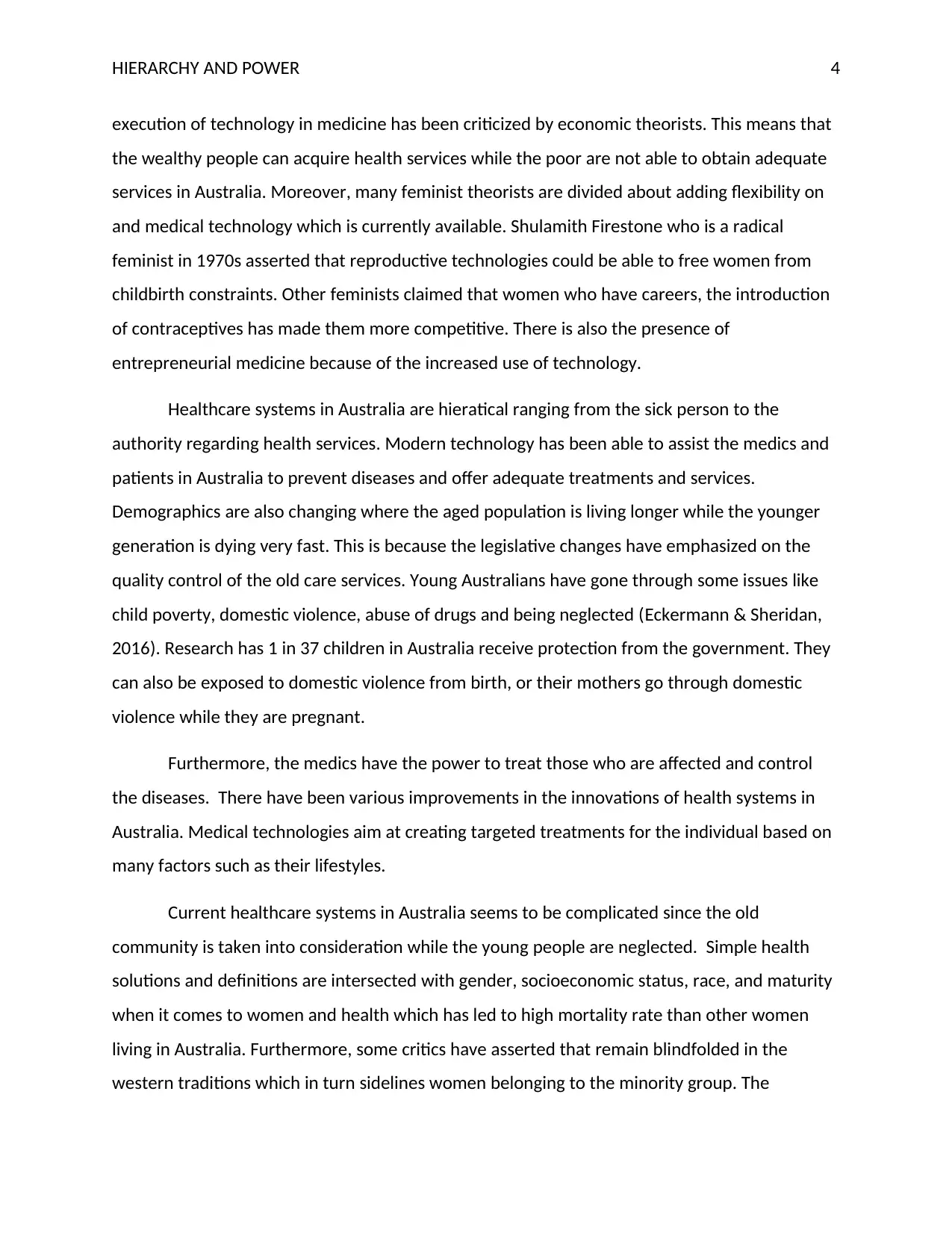
HIERARCHY AND POWER 4
execution of technology in medicine has been criticized by economic theorists. This means that
the wealthy people can acquire health services while the poor are not able to obtain adequate
services in Australia. Moreover, many feminist theorists are divided about adding flexibility on
and medical technology which is currently available. Shulamith Firestone who is a radical
feminist in 1970s asserted that reproductive technologies could be able to free women from
childbirth constraints. Other feminists claimed that women who have careers, the introduction
of contraceptives has made them more competitive. There is also the presence of
entrepreneurial medicine because of the increased use of technology.
Healthcare systems in Australia are hieratical ranging from the sick person to the
authority regarding health services. Modern technology has been able to assist the medics and
patients in Australia to prevent diseases and offer adequate treatments and services.
Demographics are also changing where the aged population is living longer while the younger
generation is dying very fast. This is because the legislative changes have emphasized on the
quality control of the old care services. Young Australians have gone through some issues like
child poverty, domestic violence, abuse of drugs and being neglected (Eckermann & Sheridan,
2016). Research has 1 in 37 children in Australia receive protection from the government. They
can also be exposed to domestic violence from birth, or their mothers go through domestic
violence while they are pregnant.
Furthermore, the medics have the power to treat those who are affected and control
the diseases. There have been various improvements in the innovations of health systems in
Australia. Medical technologies aim at creating targeted treatments for the individual based on
many factors such as their lifestyles.
Current healthcare systems in Australia seems to be complicated since the old
community is taken into consideration while the young people are neglected. Simple health
solutions and definitions are intersected with gender, socioeconomic status, race, and maturity
when it comes to women and health which has led to high mortality rate than other women
living in Australia. Furthermore, some critics have asserted that remain blindfolded in the
western traditions which in turn sidelines women belonging to the minority group. The
execution of technology in medicine has been criticized by economic theorists. This means that
the wealthy people can acquire health services while the poor are not able to obtain adequate
services in Australia. Moreover, many feminist theorists are divided about adding flexibility on
and medical technology which is currently available. Shulamith Firestone who is a radical
feminist in 1970s asserted that reproductive technologies could be able to free women from
childbirth constraints. Other feminists claimed that women who have careers, the introduction
of contraceptives has made them more competitive. There is also the presence of
entrepreneurial medicine because of the increased use of technology.
Healthcare systems in Australia are hieratical ranging from the sick person to the
authority regarding health services. Modern technology has been able to assist the medics and
patients in Australia to prevent diseases and offer adequate treatments and services.
Demographics are also changing where the aged population is living longer while the younger
generation is dying very fast. This is because the legislative changes have emphasized on the
quality control of the old care services. Young Australians have gone through some issues like
child poverty, domestic violence, abuse of drugs and being neglected (Eckermann & Sheridan,
2016). Research has 1 in 37 children in Australia receive protection from the government. They
can also be exposed to domestic violence from birth, or their mothers go through domestic
violence while they are pregnant.
Furthermore, the medics have the power to treat those who are affected and control
the diseases. There have been various improvements in the innovations of health systems in
Australia. Medical technologies aim at creating targeted treatments for the individual based on
many factors such as their lifestyles.
Current healthcare systems in Australia seems to be complicated since the old
community is taken into consideration while the young people are neglected. Simple health
solutions and definitions are intersected with gender, socioeconomic status, race, and maturity
when it comes to women and health which has led to high mortality rate than other women
living in Australia. Furthermore, some critics have asserted that remain blindfolded in the
western traditions which in turn sidelines women belonging to the minority group. The
Paraphrase This Document
Need a fresh take? Get an instant paraphrase of this document with our AI Paraphraser

HIERARCHY AND POWER 5
women’s health movement has accepted the comprehension and its differences and control
concerning health. Aboriginal women have survived unjustly in the Australian health care
system. Additionally, lesbians have been marginalized and neglected in strategies and plans
designed to fight with sexually transmitted infections including AIDS. They have also been
ignored in debates on topics such as infertility and research (Australia, n.d).
Studies have indicated in the World Health Organization; health care systems
necessitates actions that aim at promoting and maintaining the health of all people regardless
of their status (Australia, 2018). A good health care system gives healthcare justly to all citizens
and when they need it. For a particular country, there must be different elements like funding,
qualified experts, useful information, excellent facilities and medicine and technology
possibilities which also differs from other nations. The experts work in unity, and they also
come from both the public and private zones. The public sector is supported by the government
while the closed zone is sponsored individually (Read, 2018).
The healthcare systems consist of both formal and non-informal services whose main
aim is to maintain health. The three tiers of government: commonwealth, territories, and local
have a role to play in the health sector. Commonwealth deals with primary leadership
responsibility in making policy while the state and the region are associated with management
and service delivery. Australia has a universal insurance system where individuals contribute
money pro rata based on their salaries. It was founded on the moral basis that all people in
Australia have a right to essential healthcare services. However, the universal model of
Australian health is currently changing. The health system is developing which emphasizes
efficiency and rationality. Many health insurance companies are coming up to provide quality
services to the people of Australia.
The health care systems of Australia includes numerous healthcare givers. The roles are
divided between different areas and levels of the government and non-governmental
organizations. The government of Australia is responsible for healthcare funding through
insurance arrangements and direct payments to the states and territories while the states and
Territories are responsible for service provision directly (Azzopardi et al., 2018). The
women’s health movement has accepted the comprehension and its differences and control
concerning health. Aboriginal women have survived unjustly in the Australian health care
system. Additionally, lesbians have been marginalized and neglected in strategies and plans
designed to fight with sexually transmitted infections including AIDS. They have also been
ignored in debates on topics such as infertility and research (Australia, n.d).
Studies have indicated in the World Health Organization; health care systems
necessitates actions that aim at promoting and maintaining the health of all people regardless
of their status (Australia, 2018). A good health care system gives healthcare justly to all citizens
and when they need it. For a particular country, there must be different elements like funding,
qualified experts, useful information, excellent facilities and medicine and technology
possibilities which also differs from other nations. The experts work in unity, and they also
come from both the public and private zones. The public sector is supported by the government
while the closed zone is sponsored individually (Read, 2018).
The healthcare systems consist of both formal and non-informal services whose main
aim is to maintain health. The three tiers of government: commonwealth, territories, and local
have a role to play in the health sector. Commonwealth deals with primary leadership
responsibility in making policy while the state and the region are associated with management
and service delivery. Australia has a universal insurance system where individuals contribute
money pro rata based on their salaries. It was founded on the moral basis that all people in
Australia have a right to essential healthcare services. However, the universal model of
Australian health is currently changing. The health system is developing which emphasizes
efficiency and rationality. Many health insurance companies are coming up to provide quality
services to the people of Australia.
The health care systems of Australia includes numerous healthcare givers. The roles are
divided between different areas and levels of the government and non-governmental
organizations. The government of Australia is responsible for healthcare funding through
insurance arrangements and direct payments to the states and territories while the states and
Territories are responsible for service provision directly (Azzopardi et al., 2018). The

HIERARCHY AND POWER 6
government of Australia utilizes universal benefits schemes. It contributes to hospital funding
for government infirmary through Australian Healthcare Agreements. Government infirmary
services which include outpatient health centers like those that are part of infirmary genetics
services which are done by the state and government territories. The self-sponsored
healthcare involves private medical experts, sanatoriums, pharmacies and pathology services.
In most casual occasions, the wealthy individuals can acquire excellent and quality healthcare
services in the private sector whereas the poor individual struggle for their services in the public
hospitals that are near them.
The Australian Institute of Health and Welfare has estimated that the total health
expenditure was $66.6 billion in 2001-2002. Many of the Australian public funding went to
medical services and public infirmaries. Numerous territory, state, and local government
healthcare funding were given to government hospitals. There are many concerns involving
new technology in the context of budgets that are fixed set by the state might manipulate the
resources balance devoted to different features of the healthcare systems. The techniques have
the potential to strain the health care system capacity to be afforded. Many medical
practitioners view technology as a reason for the healthcare spending rising (Vilcahuamán &
Rivas, 2017).
Healthcare lies within a more comprehensive social situation, and health is affected by
many social factors. Social determinants of health play a critical responsibility in the health of
each person in Australia. Societal inequities that are available in the structure of resources are
different, and they can be striking. Some of these inequities can differentiate life and death in
many ways. Social support, community safety, education, income, employment, and social
support are all elements of economic and social determinants of health (Sheaff et al., 2010).
Political parties have political ideologies which influence health policies in Australia. Before
certain decisions are made, the Australian government impacts assessment to make the policy
makers aware of about the potential result of a system on the community's health and
wellbeing. The politicians are more involved in the advancing costs of health care, and they see
policies as part of the recommendations needed to improve health care systems in Australia.
government of Australia utilizes universal benefits schemes. It contributes to hospital funding
for government infirmary through Australian Healthcare Agreements. Government infirmary
services which include outpatient health centers like those that are part of infirmary genetics
services which are done by the state and government territories. The self-sponsored
healthcare involves private medical experts, sanatoriums, pharmacies and pathology services.
In most casual occasions, the wealthy individuals can acquire excellent and quality healthcare
services in the private sector whereas the poor individual struggle for their services in the public
hospitals that are near them.
The Australian Institute of Health and Welfare has estimated that the total health
expenditure was $66.6 billion in 2001-2002. Many of the Australian public funding went to
medical services and public infirmaries. Numerous territory, state, and local government
healthcare funding were given to government hospitals. There are many concerns involving
new technology in the context of budgets that are fixed set by the state might manipulate the
resources balance devoted to different features of the healthcare systems. The techniques have
the potential to strain the health care system capacity to be afforded. Many medical
practitioners view technology as a reason for the healthcare spending rising (Vilcahuamán &
Rivas, 2017).
Healthcare lies within a more comprehensive social situation, and health is affected by
many social factors. Social determinants of health play a critical responsibility in the health of
each person in Australia. Societal inequities that are available in the structure of resources are
different, and they can be striking. Some of these inequities can differentiate life and death in
many ways. Social support, community safety, education, income, employment, and social
support are all elements of economic and social determinants of health (Sheaff et al., 2010).
Political parties have political ideologies which influence health policies in Australia. Before
certain decisions are made, the Australian government impacts assessment to make the policy
makers aware of about the potential result of a system on the community's health and
wellbeing. The politicians are more involved in the advancing costs of health care, and they see
policies as part of the recommendations needed to improve health care systems in Australia.
⊘ This is a preview!⊘
Do you want full access?
Subscribe today to unlock all pages.

Trusted by 1+ million students worldwide
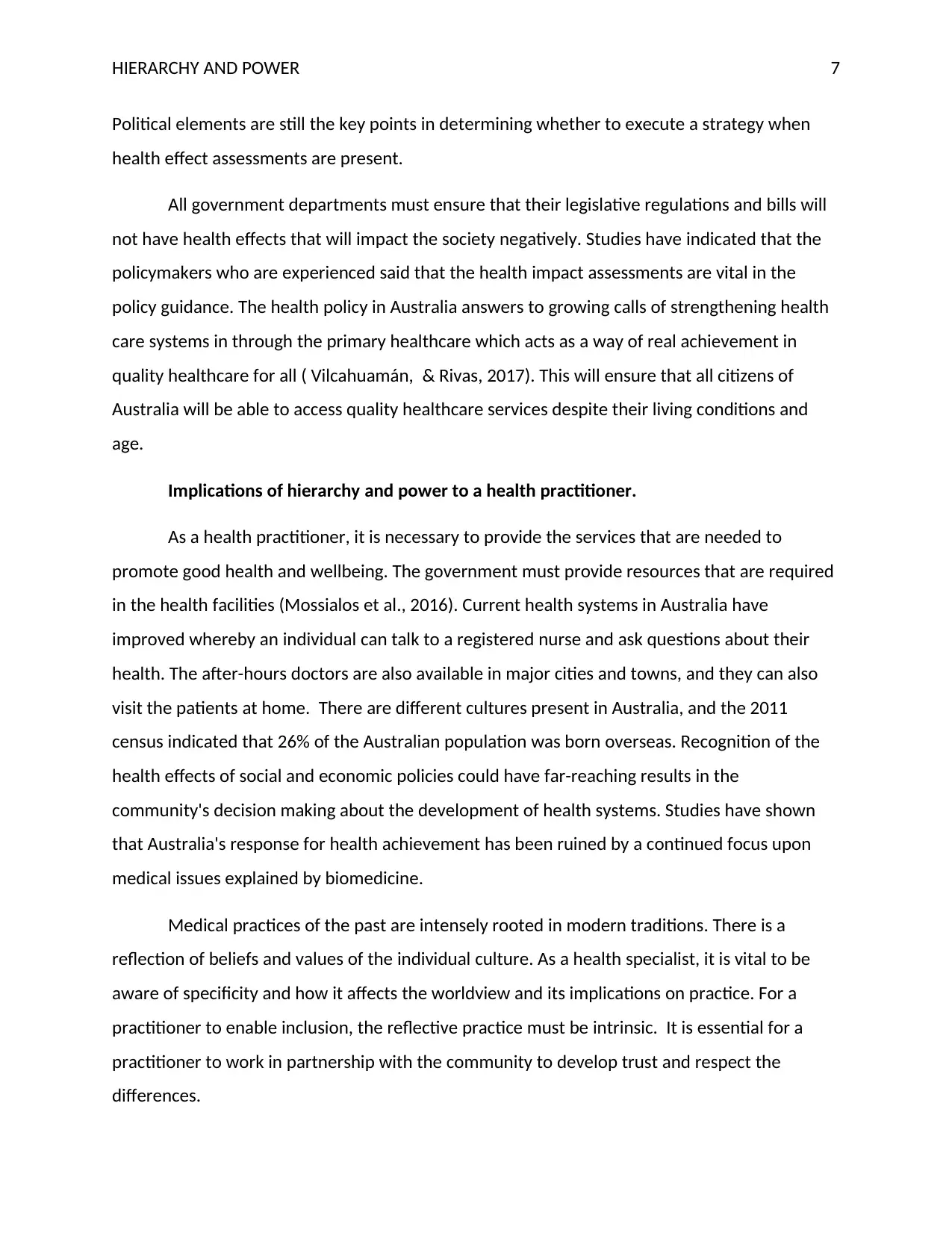
HIERARCHY AND POWER 7
Political elements are still the key points in determining whether to execute a strategy when
health effect assessments are present.
All government departments must ensure that their legislative regulations and bills will
not have health effects that will impact the society negatively. Studies have indicated that the
policymakers who are experienced said that the health impact assessments are vital in the
policy guidance. The health policy in Australia answers to growing calls of strengthening health
care systems in through the primary healthcare which acts as a way of real achievement in
quality healthcare for all ( Vilcahuamán, & Rivas, 2017). This will ensure that all citizens of
Australia will be able to access quality healthcare services despite their living conditions and
age.
Implications of hierarchy and power to a health practitioner.
As a health practitioner, it is necessary to provide the services that are needed to
promote good health and wellbeing. The government must provide resources that are required
in the health facilities (Mossialos et al., 2016). Current health systems in Australia have
improved whereby an individual can talk to a registered nurse and ask questions about their
health. The after-hours doctors are also available in major cities and towns, and they can also
visit the patients at home. There are different cultures present in Australia, and the 2011
census indicated that 26% of the Australian population was born overseas. Recognition of the
health effects of social and economic policies could have far-reaching results in the
community's decision making about the development of health systems. Studies have shown
that Australia's response for health achievement has been ruined by a continued focus upon
medical issues explained by biomedicine.
Medical practices of the past are intensely rooted in modern traditions. There is a
reflection of beliefs and values of the individual culture. As a health specialist, it is vital to be
aware of specificity and how it affects the worldview and its implications on practice. For a
practitioner to enable inclusion, the reflective practice must be intrinsic. It is essential for a
practitioner to work in partnership with the community to develop trust and respect the
differences.
Political elements are still the key points in determining whether to execute a strategy when
health effect assessments are present.
All government departments must ensure that their legislative regulations and bills will
not have health effects that will impact the society negatively. Studies have indicated that the
policymakers who are experienced said that the health impact assessments are vital in the
policy guidance. The health policy in Australia answers to growing calls of strengthening health
care systems in through the primary healthcare which acts as a way of real achievement in
quality healthcare for all ( Vilcahuamán, & Rivas, 2017). This will ensure that all citizens of
Australia will be able to access quality healthcare services despite their living conditions and
age.
Implications of hierarchy and power to a health practitioner.
As a health practitioner, it is necessary to provide the services that are needed to
promote good health and wellbeing. The government must provide resources that are required
in the health facilities (Mossialos et al., 2016). Current health systems in Australia have
improved whereby an individual can talk to a registered nurse and ask questions about their
health. The after-hours doctors are also available in major cities and towns, and they can also
visit the patients at home. There are different cultures present in Australia, and the 2011
census indicated that 26% of the Australian population was born overseas. Recognition of the
health effects of social and economic policies could have far-reaching results in the
community's decision making about the development of health systems. Studies have shown
that Australia's response for health achievement has been ruined by a continued focus upon
medical issues explained by biomedicine.
Medical practices of the past are intensely rooted in modern traditions. There is a
reflection of beliefs and values of the individual culture. As a health specialist, it is vital to be
aware of specificity and how it affects the worldview and its implications on practice. For a
practitioner to enable inclusion, the reflective practice must be intrinsic. It is essential for a
practitioner to work in partnership with the community to develop trust and respect the
differences.
Paraphrase This Document
Need a fresh take? Get an instant paraphrase of this document with our AI Paraphraser
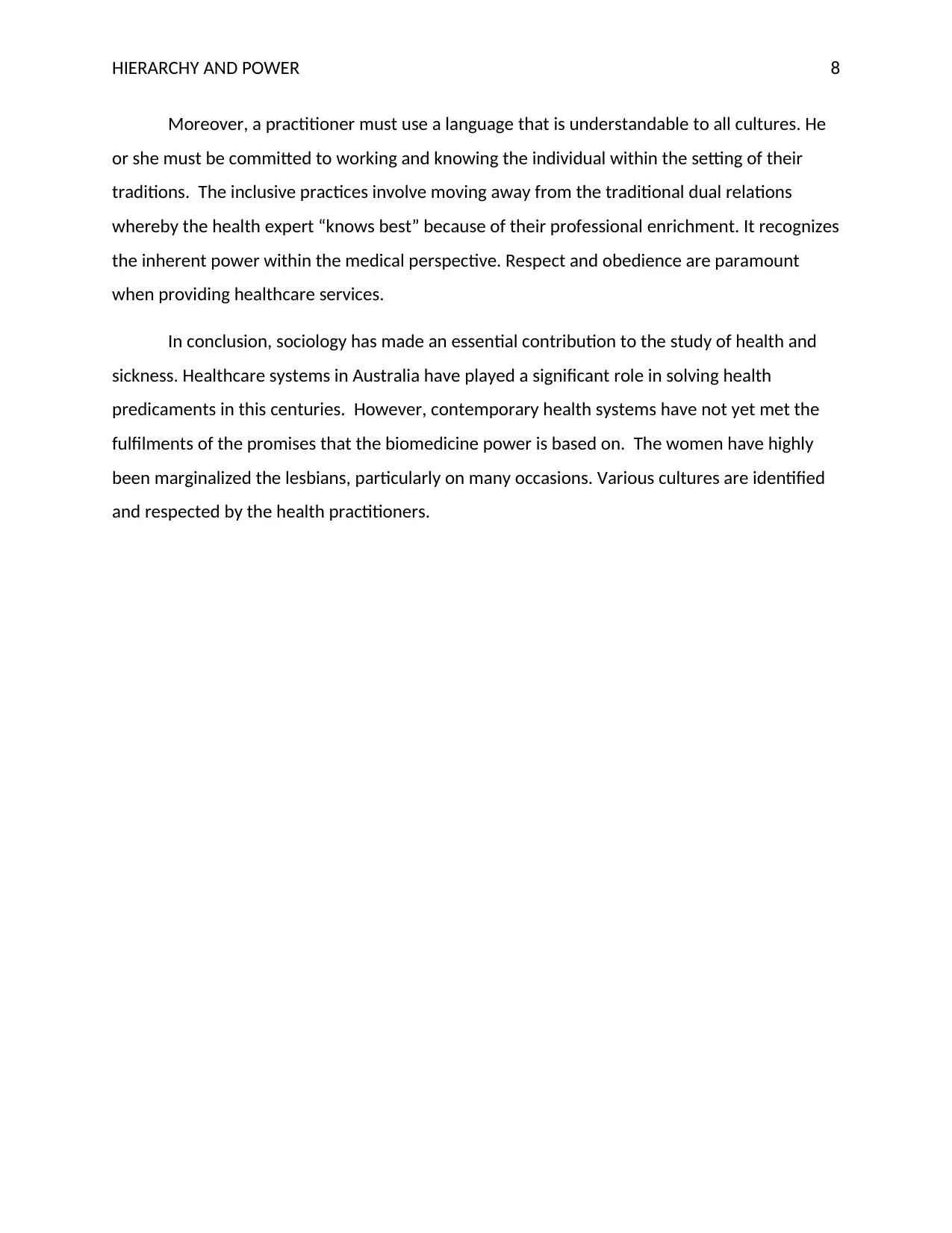
HIERARCHY AND POWER 8
Moreover, a practitioner must use a language that is understandable to all cultures. He
or she must be committed to working and knowing the individual within the setting of their
traditions. The inclusive practices involve moving away from the traditional dual relations
whereby the health expert “knows best” because of their professional enrichment. It recognizes
the inherent power within the medical perspective. Respect and obedience are paramount
when providing healthcare services.
In conclusion, sociology has made an essential contribution to the study of health and
sickness. Healthcare systems in Australia have played a significant role in solving health
predicaments in this centuries. However, contemporary health systems have not yet met the
fulfilments of the promises that the biomedicine power is based on. The women have highly
been marginalized the lesbians, particularly on many occasions. Various cultures are identified
and respected by the health practitioners.
Moreover, a practitioner must use a language that is understandable to all cultures. He
or she must be committed to working and knowing the individual within the setting of their
traditions. The inclusive practices involve moving away from the traditional dual relations
whereby the health expert “knows best” because of their professional enrichment. It recognizes
the inherent power within the medical perspective. Respect and obedience are paramount
when providing healthcare services.
In conclusion, sociology has made an essential contribution to the study of health and
sickness. Healthcare systems in Australia have played a significant role in solving health
predicaments in this centuries. However, contemporary health systems have not yet met the
fulfilments of the promises that the biomedicine power is based on. The women have highly
been marginalized the lesbians, particularly on many occasions. Various cultures are identified
and respected by the health practitioners.
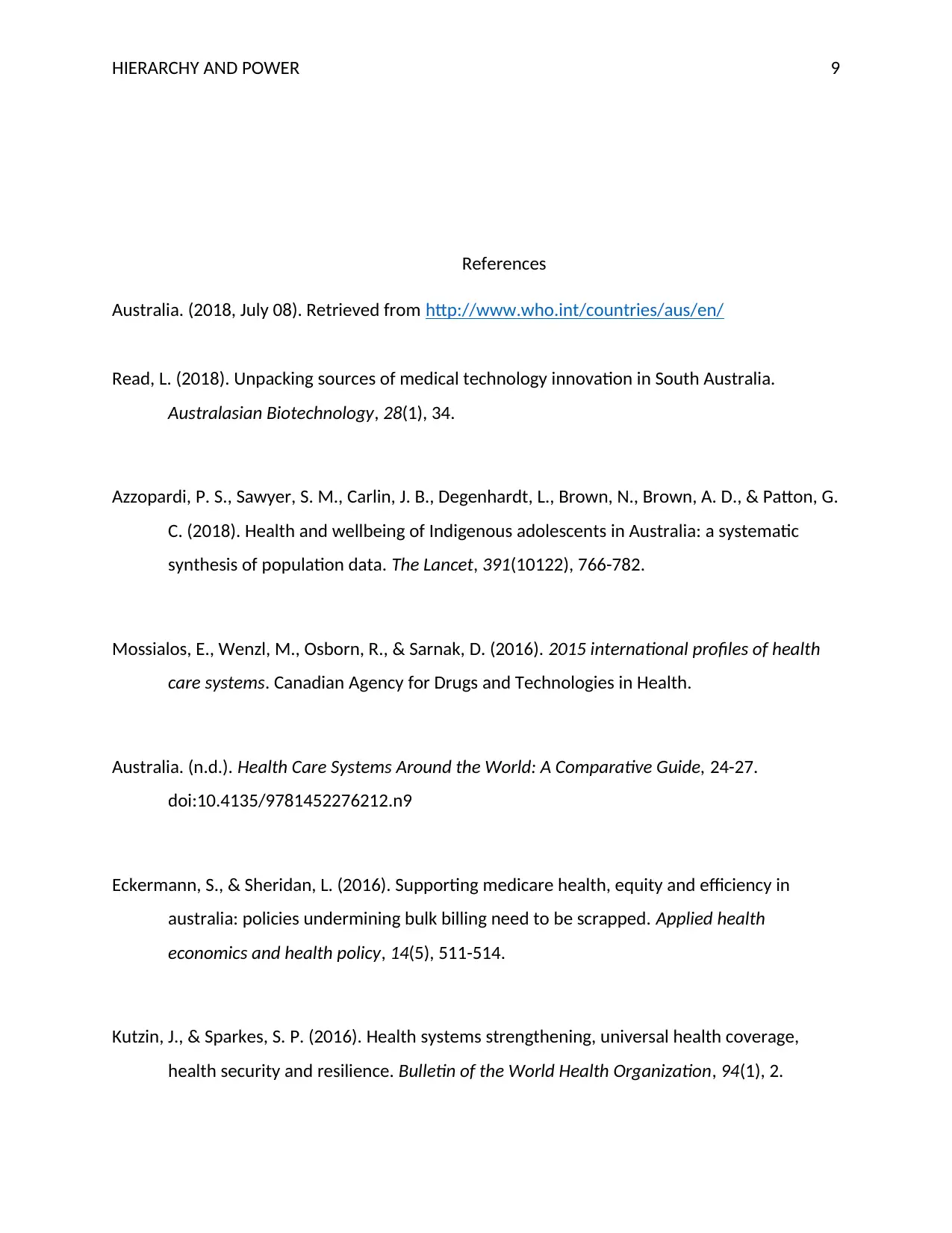
HIERARCHY AND POWER 9
References
Australia. (2018, July 08). Retrieved from http://www.who.int/countries/aus/en/
Read, L. (2018). Unpacking sources of medical technology innovation in South Australia.
Australasian Biotechnology, 28(1), 34.
Azzopardi, P. S., Sawyer, S. M., Carlin, J. B., Degenhardt, L., Brown, N., Brown, A. D., & Patton, G.
C. (2018). Health and wellbeing of Indigenous adolescents in Australia: a systematic
synthesis of population data. The Lancet, 391(10122), 766-782.
Mossialos, E., Wenzl, M., Osborn, R., & Sarnak, D. (2016). 2015 international profiles of health
care systems. Canadian Agency for Drugs and Technologies in Health.
Australia. (n.d.). Health Care Systems Around the World: A Comparative Guide, 24-27.
doi:10.4135/9781452276212.n9
Eckermann, S., & Sheridan, L. (2016). Supporting medicare health, equity and efficiency in
australia: policies undermining bulk billing need to be scrapped. Applied health
economics and health policy, 14(5), 511-514.
Kutzin, J., & Sparkes, S. P. (2016). Health systems strengthening, universal health coverage,
health security and resilience. Bulletin of the World Health Organization, 94(1), 2.
References
Australia. (2018, July 08). Retrieved from http://www.who.int/countries/aus/en/
Read, L. (2018). Unpacking sources of medical technology innovation in South Australia.
Australasian Biotechnology, 28(1), 34.
Azzopardi, P. S., Sawyer, S. M., Carlin, J. B., Degenhardt, L., Brown, N., Brown, A. D., & Patton, G.
C. (2018). Health and wellbeing of Indigenous adolescents in Australia: a systematic
synthesis of population data. The Lancet, 391(10122), 766-782.
Mossialos, E., Wenzl, M., Osborn, R., & Sarnak, D. (2016). 2015 international profiles of health
care systems. Canadian Agency for Drugs and Technologies in Health.
Australia. (n.d.). Health Care Systems Around the World: A Comparative Guide, 24-27.
doi:10.4135/9781452276212.n9
Eckermann, S., & Sheridan, L. (2016). Supporting medicare health, equity and efficiency in
australia: policies undermining bulk billing need to be scrapped. Applied health
economics and health policy, 14(5), 511-514.
Kutzin, J., & Sparkes, S. P. (2016). Health systems strengthening, universal health coverage,
health security and resilience. Bulletin of the World Health Organization, 94(1), 2.
⊘ This is a preview!⊘
Do you want full access?
Subscribe today to unlock all pages.

Trusted by 1+ million students worldwide
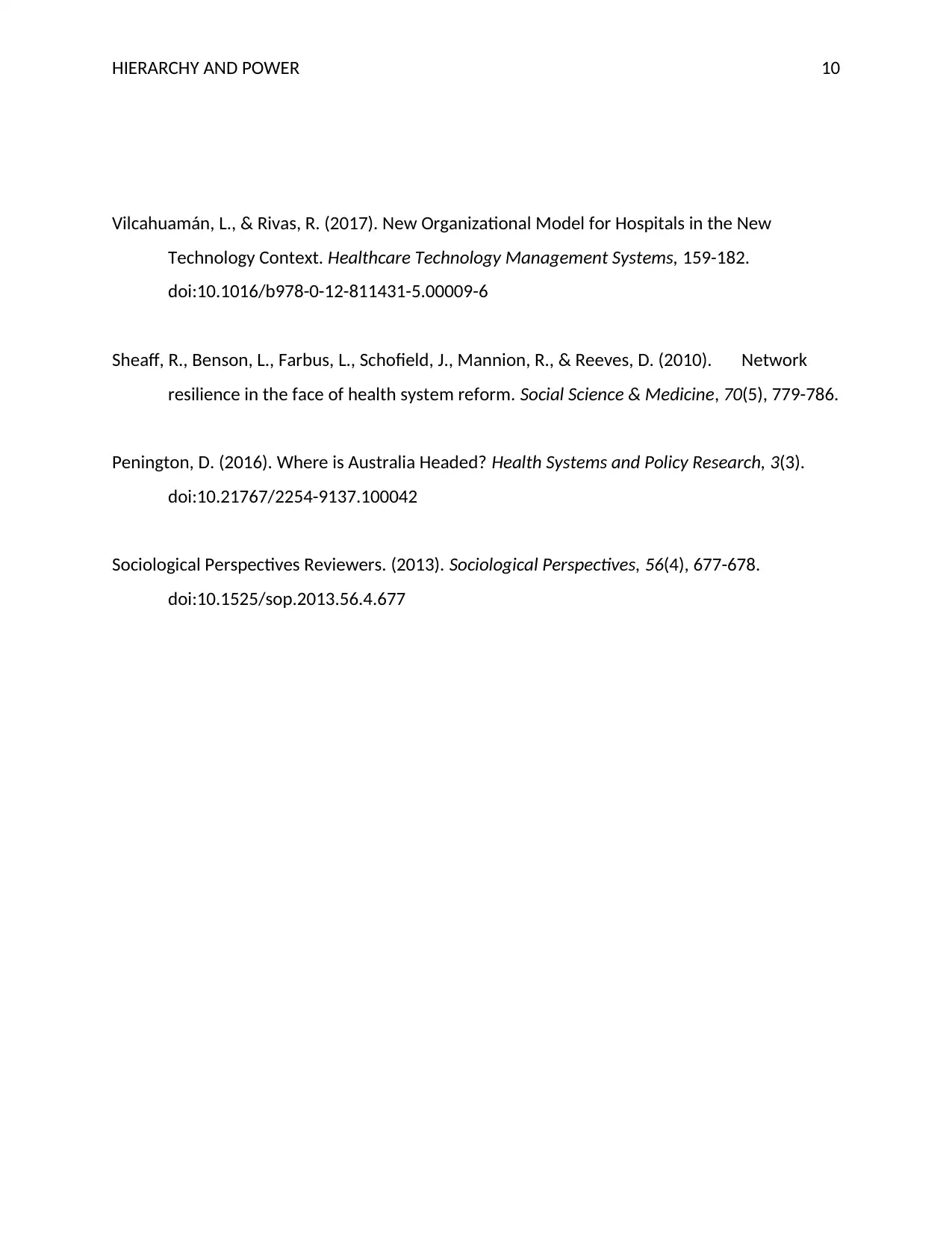
HIERARCHY AND POWER 10
Vilcahuamán, L., & Rivas, R. (2017). New Organizational Model for Hospitals in the New
Technology Context. Healthcare Technology Management Systems, 159-182.
doi:10.1016/b978-0-12-811431-5.00009-6
Sheaff, R., Benson, L., Farbus, L., Schofield, J., Mannion, R., & Reeves, D. (2010). Network
resilience in the face of health system reform. Social Science & Medicine, 70(5), 779-786.
Penington, D. (2016). Where is Australia Headed? Health Systems and Policy Research, 3(3).
doi:10.21767/2254-9137.100042
Sociological Perspectives Reviewers. (2013). Sociological Perspectives, 56(4), 677-678.
doi:10.1525/sop.2013.56.4.677
Vilcahuamán, L., & Rivas, R. (2017). New Organizational Model for Hospitals in the New
Technology Context. Healthcare Technology Management Systems, 159-182.
doi:10.1016/b978-0-12-811431-5.00009-6
Sheaff, R., Benson, L., Farbus, L., Schofield, J., Mannion, R., & Reeves, D. (2010). Network
resilience in the face of health system reform. Social Science & Medicine, 70(5), 779-786.
Penington, D. (2016). Where is Australia Headed? Health Systems and Policy Research, 3(3).
doi:10.21767/2254-9137.100042
Sociological Perspectives Reviewers. (2013). Sociological Perspectives, 56(4), 677-678.
doi:10.1525/sop.2013.56.4.677
1 out of 10
Related Documents
Your All-in-One AI-Powered Toolkit for Academic Success.
+13062052269
info@desklib.com
Available 24*7 on WhatsApp / Email
![[object Object]](/_next/static/media/star-bottom.7253800d.svg)
Unlock your academic potential
Copyright © 2020–2025 A2Z Services. All Rights Reserved. Developed and managed by ZUCOL.




